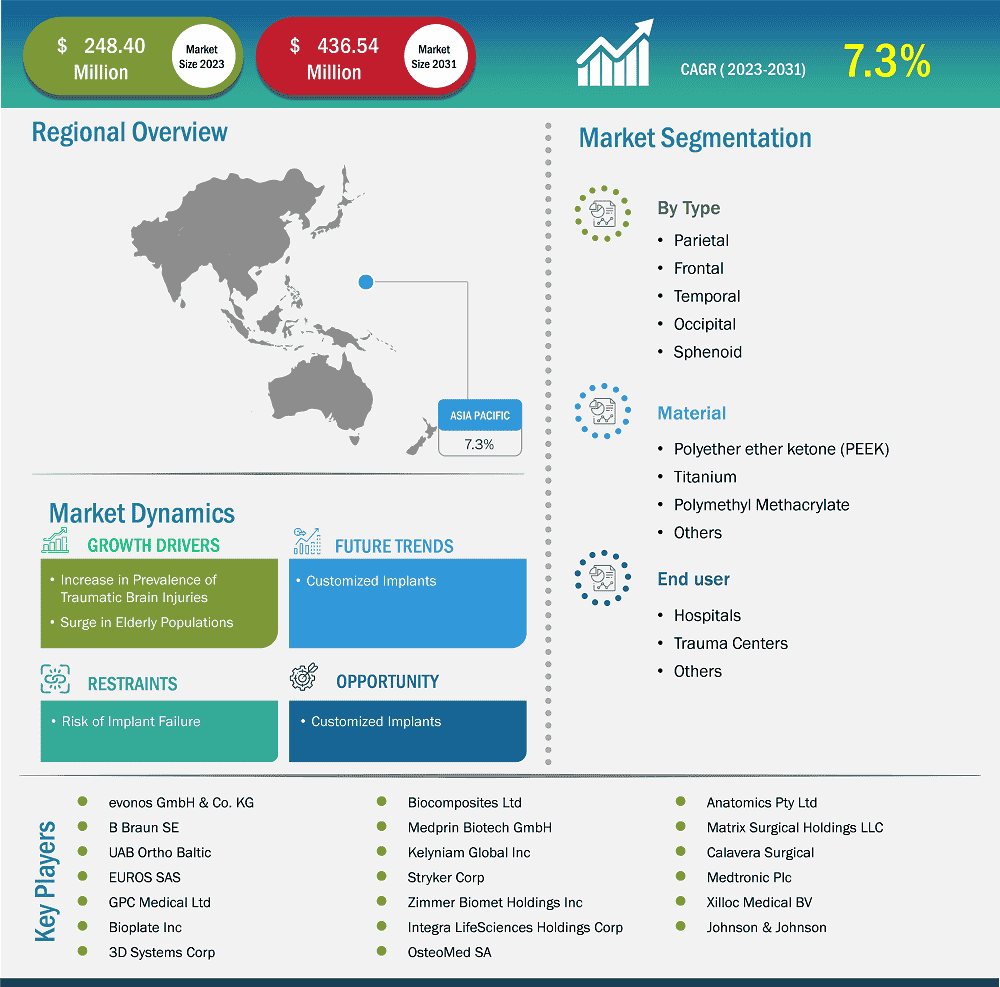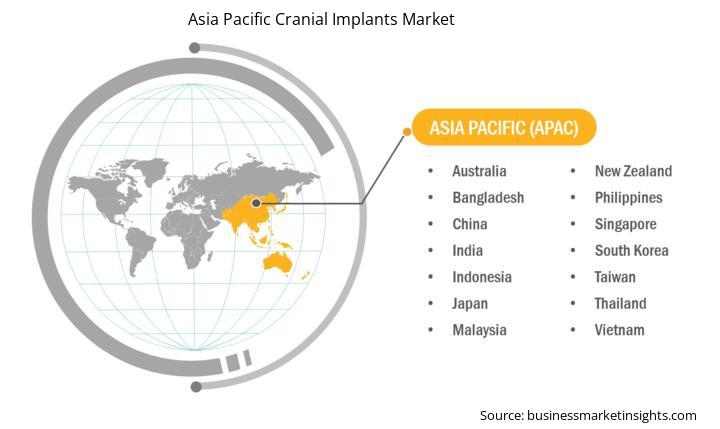Asia Pacific Cranial Implants Market Report (2021-2031) by Scope, Segmentation, Dynamics, and Competitive Analysis.
No. of Pages: 201 | Report Code: BMIRE00031982 | Category: Life Sciences
No. of Pages: 201 | Report Code: BMIRE00031982 | Category: Life Sciences
The Asia Pacific cranial implants market size is expected to reach US$ 436.54 million by 2031 from US$ 248.40 million in 2023. The market is estimated to record a CAGR of 7.3% from 2023 to 2031.
Asia Pacific is the fastest-growing market for cranial implants across the globe. The Asia Pacific cranial implants market is segmented into China, Japan, India, South Korea, Australia, and the Rest of Asia Pacific. China, India, and Japan are three significant contributors to the market growth in this region, owing to the rise in geriatric population and a surge in neurological disease prevalence, which are likely to boost the market growth during the forecast period. The proactive government initiatives and awareness campaigns led by non-governmental organizations further support the market growth. The presence of numerous industry players in countries such as Japan, China, and India significantly contribute to the expansion of the region's market.
Asia Pacific Cranial Implants Market Strategic Insights

Asia Pacific Cranial Implants Market Segmentation Analysis
Key segments that contributed to the derivation of the Asia Pacific cranial implants market analysis are type, material, and application.
3D printing, also known as additive manufacturing, allows for the creation of highly customized, patient-specific cranial implants that offer improved fit and functionality compared to traditional implants. The design and production of cranial implants have evolved with the progress in this technology, enabling precise replication of an individual’s skull geometry, which reduces the risk of surgical complications and enhances recovery outcomes. The integration of multilayer technology in 3D printing further enhances these benefits. This technology enables the creation of implants with multiple layers; each designed with different properties tailored to specific functions. For instance, one layer might be engineered for structural strength, while another could focus on biocompatibility or flexibility. Multilayered 3D-printed implants can improve osseointegration (bone growth into the implant), reduce the risk of implant rejection, and offer superior protection for the brain.
3D printing allows for faster production times, lower manufacturing costs, and greater flexibility in adapting to complex cranial deformities. These advancements not only improve patient outcomes but also reduce the overall cost of treatment, making cranial implants more accessible to a broader patient population. As a result, advancements in 3D printing with the integration of original multilayer technology, offering improved surgical precision, reduced complications, and better long-term performance, present significant opportunities for the cranial implant market.
Based on country, the Asia Pacific cranial implants market comprises China, Japan, India, South Korea, Australia, and the Rest of Asia Pacific. China held the largest share in 2023.
According to the study titled Estimated Burden of Stroke in China in 2020, published in 2023, China recorded the incidence of stroke at 3.4 million, prevalence at 17.8 million, and mortality at 2.3 million among people aged 40 years and above in 2020. Every year, nearly 2,000,000 people experience their first stroke, and nearly 70–80% of the patients fail to live independently. Cranial implants are increasingly being utilized in the treatment and rehabilitation of stroke patients. These serve a dual purpose in stroke management: they protect and reconstruct the skull after surgical procedures and potentially aid in the recovery of motor functions. As per the article the epidemiology of traumatic brain injuries in the fastest-paced city in China, published in November 2023, ~772,800–892,800 new cases of TBIs occur annually in China. The growing occurrence of TBI fuels the demand for cranial implants. China faces several obstacles in maintaining and improving people's health due to its rapid socioeconomic development, environmental problems, lifestyle changes, and urbanization. The Chinese government introduced the Healthy China 2030 Plan, emphasizing the strategic importance of health for its economic growth. In 2018, there were ~506,003 public primary care facilities, 12,000 public hospitals, and 21,000 private hospitals in the country, excluding city and community hospitals. Policies aimed at improving healthcare access and quality are creating a favorable environment for the growth of the cranial implants market. Additionally, government investments in healthcare infrastructure and technological advancements in medical devices enhance the accessibility and effectiveness of cranial implants, thereby accelerating the growth of the market.
Asia Pacific Cranial Implants Market Report Highlights
Report Attribute
Details
Market size in 2023
US$ 248.40 Million
Market Size by 2031
US$ 436.54 Million
CAGR (2023 - 2031) 7.3%
Historical Data
2021-2022
Forecast period
2024-2031
Segments Covered
By Type
By Material
By End User
Regions and Countries Covered
Asia Pacific
Market leaders and key company profiles
Asia Pacific Cranial Implants Market Company Profiles
Some of the key players operating in the market include Stryker Corp, Zimmer Biomet Holdings Inc, Integra LifeSciences Holdings Corp, OsteoMed SA, Anatomics Pty Ltd, Matrix Surgical Holdings LLC, Calavera Surgical, Medtronic Plc, Xilloc Medical BV, Johnson & Johnson, evonos GmbH & Co. KG, B Braun SE, UAB Ortho Baltic, 3D Systems Corp, GPC Medical Ltd, Bioplate Inc, EUROS SAS, Biocomposites Ltd, Medprin Biotech GmbH, Kelyniam Global Inc, MedCAD, KLS Martin Group, and Longeviti Neuro Solutions LLC, among others. These players are adopting various strategies such as expansion, product innovation, and mergers and acquisitions to provide innovative products to their consumers and increase their market share.
The following methodology has been followed for the collection and analysis of data presented in this report:
The research process begins with comprehensive secondary research, utilizing both internal and external sources to gather qualitative and quantitative data for each market. Commonly referenced secondary research sources include, but are not limited to:
Note: All financial data included in the Company Profiles section has been standardized to USD. For companies reporting in other currencies, figures have been converted to USD using the relevant exchange rates for the corresponding year.
The Insight Partners conducts a significant number of primary interviews each year with industry stakeholders and experts to validate its data analysis and gain valuable insights. These research interviews are designed to:
Primary research is conducted via email interactions and telephone interviews, encompassing various markets, categories, segments, and sub-segments across different regions. Participants typically include:

The Asia Pacific Cranial Implants Market is valued at US$ 248.40 Million in 2023, it is projected to reach US$ 436.54 Million by 2031.
As per our report Asia Pacific Cranial Implants Market, the market size is valued at US$ 248.40 Million in 2023, projecting it to reach US$ 436.54 Million by 2031. This translates to a CAGR of approximately 7.3% during the forecast period.
The Asia Pacific Cranial Implants Market report typically cover these key segments-
The historic period, base year, and forecast period can vary slightly depending on the specific market research report. However, for the Asia Pacific Cranial Implants Market report:
The Asia Pacific Cranial Implants Market is populated by several key players, each contributing to its growth and innovation. Some of the major players include:
The Asia Pacific Cranial Implants Market report is valuable for diverse stakeholders, including:
Essentially, anyone involved in or considering involvement in the Asia Pacific Cranial Implants Market value chain can benefit from the information contained in a comprehensive market report.